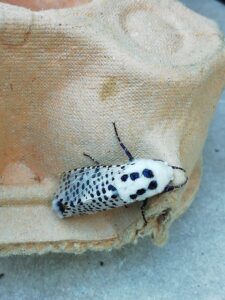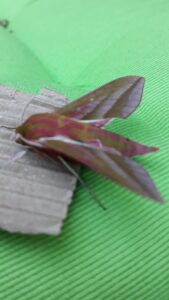There are over 2,500 species of moth in the UK: 400 are macro moths, the rest are the more difficult micro moths. In comparison, there are only 60 butterflies. There are native moths and immigrant ones and they are grouped into nineteen families. Only five of these moths can damage clothes and carpets.
The life cycle starts as an egg, which then turns into larva (caterpillar) which can moult up to four times as it grows. It then becomes a pupa, which mostly overwinters and lives on twigs, dead trees and shrubs. A moth usually lives up to five weeks and the male’s sole purpose is to mate. The female will stay around its food source where she will lay her eggs. Two of the largest UK moths are the Clifden Nonpareil (41 – 48 mm) and the Emperor Moth (35 -41 mm) sadly neither of which we have had in our garden.

Poplar Hawk Moth 
Leopard Moth 
Hawk Moth
All the traps, for recording moths, have a mercury vapour bulb but you can use a bright light with a white sheet. We have a Robinson’s trap, which we use approximately two to three times a month, never more than once a week as you are at risk of trapping the same moths. The best months for species and quantity are in the summer, with most of the beautiful hawk moths in June and July. There are only a few moths in the winter.
Encouraging moths to the garden with a wide variety of flowers and plants will also encourage other important insects like butterflies and bees.
For identification we use the Field Guide to the Moths of Great Britain and Ireland by Paul Waring and Martin Townsend, illustrated by Richard Lewington. It is not always easy to sex the moths without looking at their genitalia – this is beyond our ability! We keep a record of all we see and send the results to the Wiltshire Moth Recorder, which we have been doing for the last five years. If we are in any doubt, there is always plenty of help at hand including the very good Wiltshire Moths and Butterflies page on Facebook.
In total, we have seen 141 species of moth in our garden in Warminster.
It is a great hobby and amazing to see such beautiful creatures that usually stay hidden or only come out at night. More information can be acquired from Moths UK website https://www.ukmoths.org.uk/ and also the Butterfly Conservation website https://butterfly-conservation.org/moths/identify-a-moth
by Maggie and Steve Dettmar
